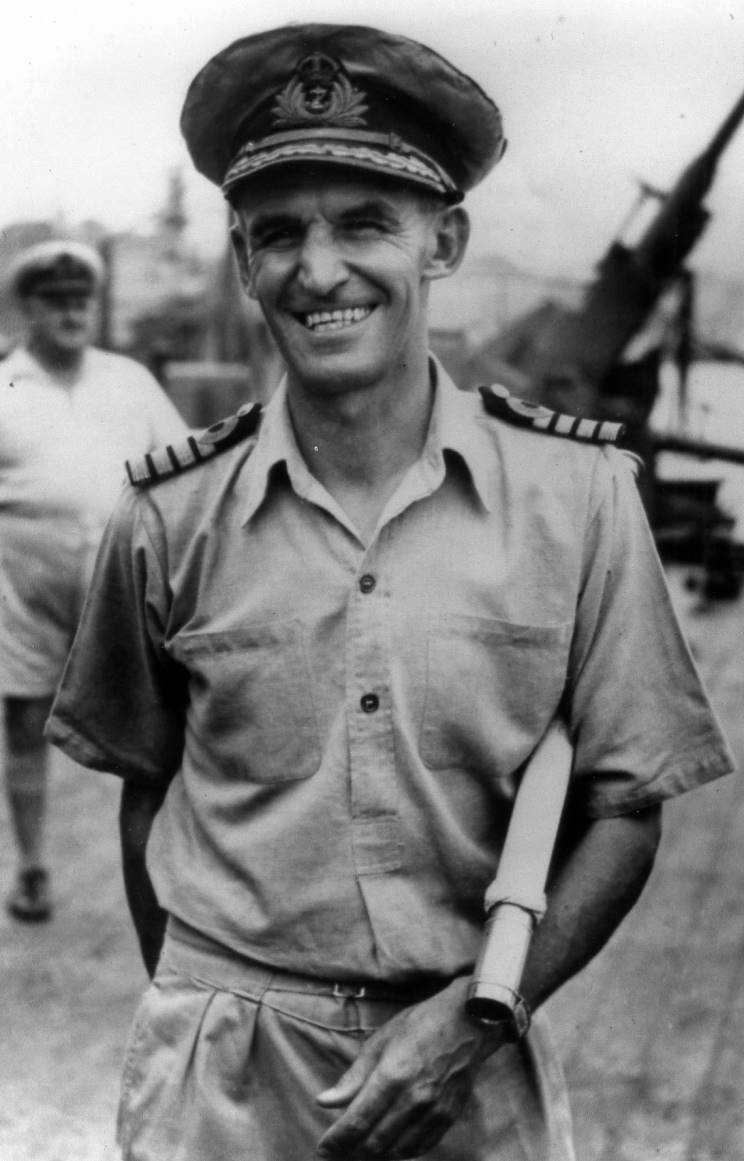Commodore John Malet Armstrong CBE DSO

John Malet Armstrong (1900–1988) was born on 5 January 1900 in Sydney. He was educated at Sydney Grammar School and All Saints College in Bathurst, New South Wales, before entering the Royal Australian Naval College in 1914. He was successively made cadet-captain and chief cadet-captain, and won his colours for rugby and swimming.
He was made a midshipman on 1 January 1918 and joined HMAS Australia (I) at Scapa Flow, Scotland, in April. Described as intelligent and tactful, and shy yet energetic, his successive commanding officers in Australia all saw promise in Armstrong. Captain Oliver Backhouse CB RN commented on 31 August 1918 that he was ‘Intelligent, keen and hardworking ... a zealous, intelligent and promising officer’. On 31 December 1918, Captain Thomas James RN, described him as ‘Very conscientious in all his duties. Has the making of a very good officer’. Captain Claude Cumberlege RN, on 19 November 1919, described him as ‘A very keen and promising officer’.
Back in Australia after the war, he joined the crew of HMAS Brisbane (I) on 18 September 1919 and was promoted to sub lieutenant the following month and lieutenant on 15 March 1921. He underwent a series of courses in Britain specialising in gunnery in the early 1920s.
He returned to Australia in October 1925, posted to HMAS Cerberus and in 1927 he was the Navy's guard commander for the opening of Parliament House in Canberra. He served in HMA Ships Adelaide (I) and Sydney (I), and, upon Sydney's decommissioning in May 1928, served for two years on exchange with the Royal Navy. He was promoted to lieutenant commander on 15 March 1929 while serving in HMS Castor on the China Station.
He returned to Australia in March 1930 and served in HMAS Australia (II) before taking on a number of staff appointments ashore. He was promoted to commander on 30 June 1935 and undertook another two year exchange posting with the Royal Navy from July 1936. He commanded HMS Broke from July 1937 to January 1938, before taking passage back to Australia. He returned to the Royal Australian Naval College, as executive officer, between March 1938 and July 1939.
He was back serving in HMAS Australia (II) as executive officer at the outbreak of the Second World War. Australia (II) was involved in patrol and escort work in the Indian Ocean in the early months of the war and, in July and September 1940, conducted operations against Vichy French forces at Dakar. He was involved in a remarkable rescue off the coast of Scotland when a Sunderland flying boat ditched in the sea in poor weather. Armstrong led a rescue team that went over side on bowlines to successfully rescue nine of the aircraft’s 13 crew. He was mentioned in dispatches in June 1941 for his service in Australia (II).
He was made acting captain on 30 April 1942 and commanded the armed merchant cruisers HMA Ships Manoora (I) and Westralia (I) during the year. At the time of his substantive promotion to captain on 31 December 1942, he was chief of staff to the flag officer in charge (FOIC) Sydney, and became naval officer in charge (NOIC) New Guinea in November 1943.
He assumed command of HMAS Australia (II) on 29 October 1944, 8days after a kamikaze attack had claimed the life of its commanding officer, Captain Emile Dechaineux DSC RAN, along with that of 6 other officers and 23 ratings. He was in command in January 1945 when Australia (II) covered the allied invasion of Luzon Island at Lingayen Gulf. The ship was subjected to repeated suicide attacks and was hit on 5, 6, 8 and 9 January; 3 officers and 41 ratings were killed and one officer and 68 ratings wounded. This was the ship’s last action in the Second World War. After repairs in Sydney, Australia (II) sailed for the United Kingdom, via the United States, on 24 May 1945 for a major refit, arriving at Plymouth on 1 July. The ship was still in the United Kingdom at the end of the war.
Armstrong was recognised with the award of the United Kingdom's Distinguished Service Order and the US Navy Cross for his command of Australia (II) at Lingayen Gulf. He relinquished command of the cruiser on 5 August 1945.
He briefly commanded the escort carriers HM Ships Vindex and Ruler before returning to Australia to be appointed second naval member of the Naval Board on 3 April 1946, with the rank of acting commodore 2nd class, a promotion which was confirmed on 24 July 1950. He was made a Commander of the Order of the British Empire on 7 June 1951.
Armstrong had been selected as captain of the RAN’s first aircraft carrier, HMAS Sydney (III), however, a broken arm, which took an unusually long time to heal due to a previous break in the same spot, precluded him from taking up the command. Ongoing problems with the injury, combined with his failing eyesight, meant that he was declared unfit for sea in July 1951.
He continued to hold staff appointments in Australia, Britain and the United States, with his final appointment as Australia’s first defence research and development representative in Washington DC. He retired on 14 August 1958.
John Malet Armstrong died on 30 December 1988 in his home at La Haule, on the island of Jersey, and his ashes were buried in the family grave in the cemetery of the parish church at St Brelade, Jersey.


